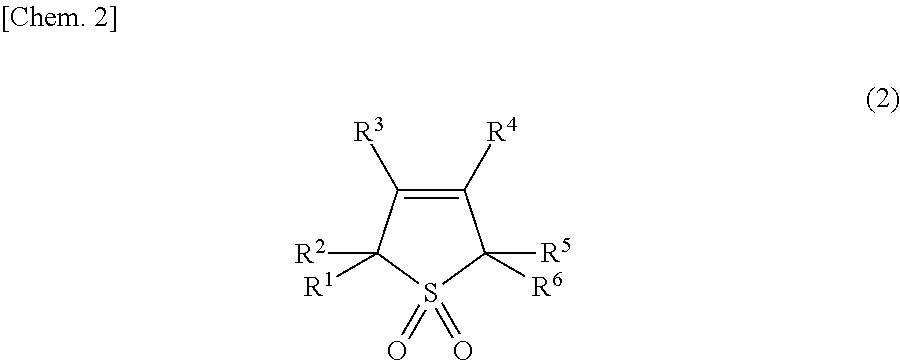Method for manufacturing sulfolene compound and method for manufacturing sulfolane compound
a technology of sulfolene compound and manufacturing method, which is applied in the field of manufacturing sulfolene compound, can solve the problems of large amount of additional catalyst and long reaction time, and achieve the effect of inhibiting polymer generation and smoothly hydrogenating sulfolene compound
- Summary
- Abstract
- Description
- Claims
- Application Information
AI Technical Summary
Benefits of technology
Problems solved by technology
Method used
Image
Examples
example 1
[0075]An amount of 0.186 g (1.0 mmol) of ferrocene was fed into a 500-mL stainless autoclave equipped with a stirrer, a thermometer, a pressure gauge, and a heater. Then, 77 g of sulfur dioxide was charged therein. Next, the autoclave was heated to 100° C. and 54 g (1.0 mol) of 1,3-butadiene was injected thereto at a rate of 0.38 g / min using a pump. The mixture was stirred for one hour at 100° C. During the stirring, the pressure inside the autoclave was 2.7 to 0.7 MPa.
[0076]After the pressure inside the autoclave was discharged, 150 g of water was added and the autoclave was cooled to 60° C. The autoclave contents were filtered through a filter paper to give a 3-sulfolene aqueous solution. The amount of 3-sulfolene in the obtained aqueous solution was measured using liquid chromatography and the measurement was 103 g (0.87 mol). The yield from 1,3-butadiene was 87%. It is to be noted that polymers were not found on the filter paper used in filtering.
[0077]All of the obtained 3-sulf...
example 2
[0079]Except that the amount of ferrocene used in manufacturing of sulfolene was changed to 0.019 g (0.10 mmol), a 3-sulfolene aqueous solution was prepared in the same manner as in Example 1. The amount of 3-sulfolene in the obtained aqueous solution was 104 g (0.88 mol) and the yield from 1,3-butadiene was 88%. Polymers were not found on the filter paper after filtering the 3-sulfolene aqueous solution. Next, the obtained 3-sulfolene aqueous solution was hydrogenated in the same manner as in Example 1. The reaction time was 98 minutes and the reaction was 100% progressed. Table 1 shows the measurements of the amount of generated polymers and the reaction time of hydrogenation.
example 3
[0080]Except that the amount of ferrocene used in manufacturing of sulfolene was changed to 0.002 g (0.01 mmol), a 3-sulfolene aqueous solution was prepared in the same manner as in Example 1. The amount of 3-sulfolene in the obtained aqueous solution was 104 g (0.88 mol) and the yield from 1,3-butadiene was 88%. An amount of 0.001 g of polymers was found on the filter paper after filtering the 3-sulfolene aqueous solution. Next, the obtained 3-sulfolene aqueous solution was hydrogenated in the same manner as in Example 1. The reaction time was 90 minutes and the reaction was 100% progressed. Table 1 shows the measurements of the amount of generated polymers and the reaction time of hydrogenation.
PUM
| Property | Measurement | Unit |
|---|---|---|
| temperature | aaaaa | aaaaa |
| temperature | aaaaa | aaaaa |
| pressure | aaaaa | aaaaa |
Abstract
Description
Claims
Application Information
 Login to View More
Login to View More - R&D
- Intellectual Property
- Life Sciences
- Materials
- Tech Scout
- Unparalleled Data Quality
- Higher Quality Content
- 60% Fewer Hallucinations
Browse by: Latest US Patents, China's latest patents, Technical Efficacy Thesaurus, Application Domain, Technology Topic, Popular Technical Reports.
© 2025 PatSnap. All rights reserved.Legal|Privacy policy|Modern Slavery Act Transparency Statement|Sitemap|About US| Contact US: help@patsnap.com



